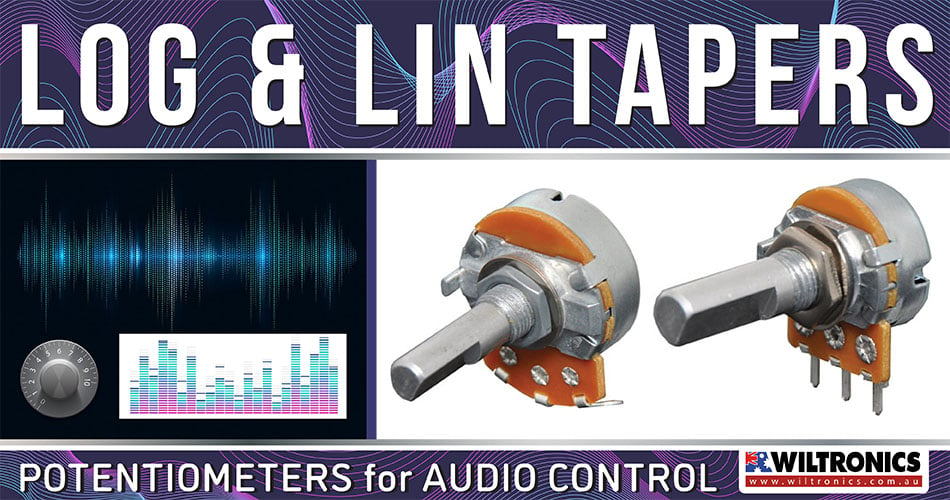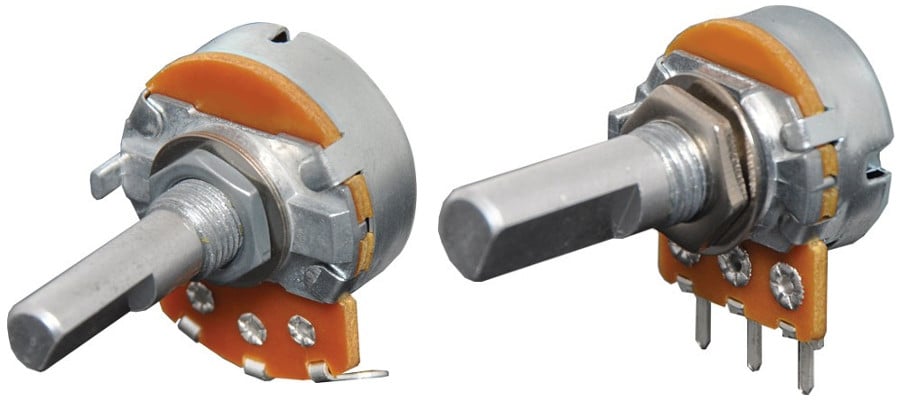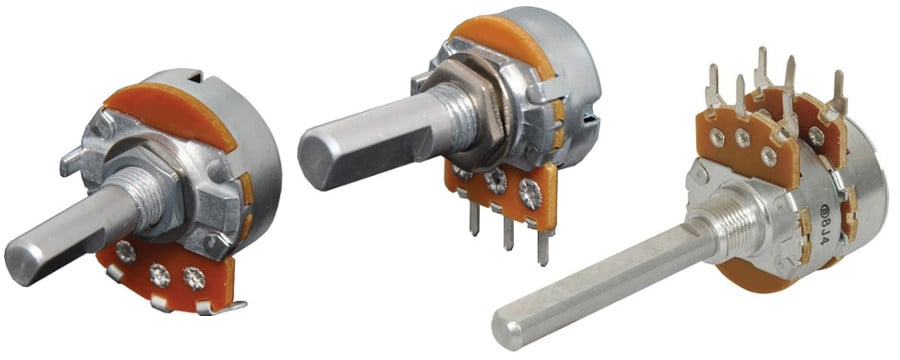Log and Lin Tapers: Potentiometers for Audio Control
October 17, 2022

Generally, you can use potentiometers in two ways: 1.) as a voltage divider for measuring electric currents, 2.) for volume controls, controlling audio. Wiltronics supplies Potentiometers for both these applications!
But with different potentiometers on the market, you might be confused about which one you need. If you are looking for a potentiometer for volume applications (#2), this post is for you!
Potentiometers for Volume Controls
A potentiometer is an adjustable variable resistor with three (3) terminals. It is linked between the received audio line and the ground. Two of these (the blue and green) connect to the opposite ends of a resistive element.
The third one (black) connects to a sliding contact, a wiper, moving the resistive element. The wiper attaches to the input of the next amplifier stage. The power output thus depends on the angle of the potentiometer knob.
Another term for potentiometers is potmeters or pots, and a wide variety is available. The most common form is the single-turn rotary potmeter.
It is often used in audio volume control and more—also known as logarithmic taper or log taper. This is where potentiometer tapers come into the picture.
Potentiometer Tapers
One of the concepts associated with potentiometers is the taper. Taper is the relationship between the position and the resistance of a potentiometer.
The majority of variable resistors are in a linear relationship. This means that the relative position is equal to the resistance ratio.
For instance, when the sliding contact is at the middle position. The variable resistance value is half of the full-scale resistance of the potmeter.
The most common types are linear (lin), and logarithmic (log) tapers:

Linear Pot Tapers
In a linear taper, the resistance with the potentiometer position is linear. Also known as slider, slide pot or fader. The relationship between the two varies at a constant rate as the slide moves along the track.
For volume applications, a lin taper pot linearly increases the signal, hence the name. For instance, “1” on your control is equal to “10”, “4” is 40% and so forth.
Simply put, it changes resistance linearly as you turn the pot wiper.
There are four (4) types of linear potentiometers based on their applications:
- Slide. A single linear slider potentiometer for audio applications, also known as a fader. High-quality faders are often constructed from conductive plastic. Best use for single channel control or measurement of distance.
- Dual-slide. A single slider controlling two potentiometers in parallel. Often used for stereo control in applications where dual parallel channels are controlled.
- Multi-turn slide. Constructed from a spindle that actuates a linear potentiometer wiper. With multiple rotations for increased precision, mostly 5, 10 or 20. Ideal use for applications where high precision and resolution are required.
- Motorised fader. It can be automatically adjusted by a servo motor. Great for where you need manual and automatic adjustment, e.g. studio audio mixers.
Potentiometers with linear taper are marked with a “B”. Check out these linear potentiometers below. Both can withstand harsh environments and wide temperature ranges:
- VCU Linear B Taper Potentiometer 24mm (Product code: PT01xx)
- V16L Linear Potentiometer – B Taper, D Shaft (Product code: PT05xx)

Logarithmic Pot Tapers
For some applications, particularly audio volume control, non-linear logarithmic (log) tapers are used. The goal is to get a more natural perception of sound intensity change when you adjust the volume. Thus, Log Potentiometers are often preferred over Linear Potentiometers for audio volume control.
The human ear’s response to sound loudness is logarithmic. Using one will give the full volume effect on the control sounds twice as loud as a setting of a half volume.
In a nutshell, a log taper changes resistance logarithmically as you turn the pot wiper. Potentiometers with logarithmic taper are marked with an “A”.
Check out these log taper pots below:
- V16L Log Potentiometer – A Taper, D Shaft (Product code: PT07xx)
- VCU Log A Taper Potentiometer D Shaft (Product code: PT03xx)
- VGU Dual Log A Potentiometer (Product code: PT23xx)
Lin to Log conversion
There is a way to get a close approximation to log operation by modifying the potentiometer. Connect a fixed resistor with a value about a quarter of the potmeter value from the low end of the pot to the slider.
As the control is adjusted, the resistor bypasses the potentiometer track. This gives a curved response like a true log operation.
Materials Used for Potentiometers
Below are the materials commonly found in potentiometers, including their properties.
Carbon composition
This is ink moulded on a substrate (phenolic resin). It is a common material, being low cost and with reasonable noise and wear characteristics.
Wirewound
Wirewound pots can handle high power, are long-lasting and can be very precise.
They are mostly used in high-power applications but have a limited resolution and rough feel.
Conductive plastic
Offers an almost infinite resolution for angles up to max. 355° at max. 400 rpm. All thanks to its resistance track!
Often used in high-end audio equipment where high resolution and low noise are vital.
Cermet
It is very stable, with a low-temperature coefficient and can handle high temperatures well. But it is quite expensive and often has a limited amount of cycles allowed.
Often used for trimpots which do not have to be adjusted often.
Potentiometers: The Bottom Line
Our ears perceive sound in a logarithmic fashion. If you use linear or lin tapers, the volume control is squeezed into the first 60 degrees or so of rotation. The rest of the rotation has little effect on audio.
Log tapers, in contrast, are best for audio applications.Their characteristics are suitable to the way our ears receive sounds. One gradually increases (or decreases) sound as you turn the wiper.
If you like to know more about electronics basics, check out more of our articles next!
© Electrotech Brands Pty Ltd 2022


Write a Comment
You must be logged in to post a comment.